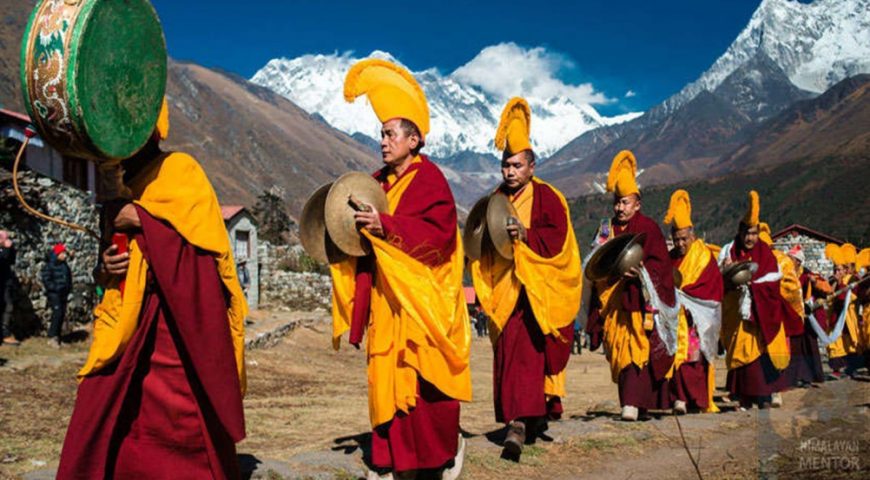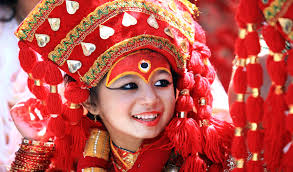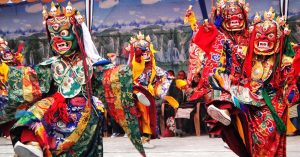
Culture in Nepal
The culture of Nepal is rich and unique. The cultural heritage of Nepal has evolved over the centuries. This multi-dimensional heritage encompasses the diversities of Nepal’s ethnic, tribal, and social groups, and it manifests in music and dance; art and craft; folklore and folktales; languages and literature; philosophy and religion; festivals and celebration; foods and drinks.
Dance and music
Legends state that dances in the Indian subcontinent originated in the abode of Lord Shiva — the Himalayas and the Himalayan Kingdom of Nepal — where he performed the tandava dance. This indicates that dance traditions of Nepal are very ancient. With altitudes and ethnicity, the dances of Nepal slightly change in style as well as in the costumes. The Dishka, a dance performed at weddings, includes intricate footwork and arm movements. Accompanying music and musical instruments change in tune with the themes, which revolve around topics like harvesting of crops, marriage rites, war stories, a lonely girl’s yearning for her love, and several other themes and stories from everyday life in the villages.
Languages and literature
As per the 2011 census, 123 languages are spoken in Nepal. Nepal’s linguistic heritage has evolved from three major language groups: Indo-Aryan, Tibeto-Burman, and indigenous. The major languages of Nepal (percent spoken as mother tongue) are Nepali (44.6%), Maithili (11.7%), Bhojpuri (6%), Tharu (5.8%), Tamang (5.1%), Nepal Bhasa (3.2%), Magar (3%) and Bajjika (3%).
Nepali, written in Devanagari script, is the official national language and serves as lingua franca among Nepalese ethno-linguistic groups. Maithili language that was originated in Mithila region of Nepal is the de facto official language of Nepal and Madhesh as a whole. Maithili is spoken in Nepal as a second language. Extinct languages of Nepal include Kusunda, Madhesiya and Waling.
Religions and philosophy
The 2001 census identified 80.6% of the population being Hindu. Buddhism was practiced by about 11% of the population (although many people labelled Hindu or Buddhist often practice a syncretic blend of Hinduism, Buddhism, and/or animist traditions). About 3.2% practice Islam and 3.6% of the population follows the indigenous Kirant religion. Christianity is practiced officially by less than 0.5%.
Hindu and Buddhist traditions in Nepal go back more than two millennia. In Lumbini, Buddha was born, and Pashupatinath temple, Kathmandu, is an old and famous Shiva temple of Hindus. Nepal has several other temples and Buddhist monasteries, as well as places of worship of other religious groups. Traditionally, Nepalese philosophical thoughts are ingrained with the Hindu and Buddhist philosophical ethos and traditions, which include elements of Kashmir Shaivism, Nyingma school of Tibetan Buddhism, works of Karmacharyas of Bhaktapur, and tantric traditions. Tantric traditions are deep rooted in Nepal, including the practice of animal sacrifices. Five types of animals, always male, are considered acceptable for sacrifice: water buffalo, goats, sheep, chickens, and ducks. Cows are very sacred animals and are never considered acceptable for sacrifice.

Festivals and celebrations
Several of the festivals of Nepal last from one to several days. Dashain is the longest and the most important festival of Nepal. Generally Dashain falls in late September to mid-October, right after the end of the monsoon season. It is “a day of Victory over Demons”. The Newars celebrate the festival as Mohani. Tihar or Swanti and Chhath are another important festivals of Nepal. New Year’s Day of the lunar calendar Nepal Sambat occurs at this time.
Other important festivals include Buddha Jayanti (the celebration of the birth of Buddha)Maha Shivaratri (a festival of Lord Shiva) and during Maha Shivaratri festivities, some people consume excessive drinks and smoke charas.Sherpas, mostly located at higher altitudes and in the Mount Everest region, celebrate Mani Rimdu, for the good of the world.
Most festivals include dancing and music, and a variety of foods are consumed during festivals and on special occasions.
The Sagan ceremony is the ritualized presentation of five food items (boiled egg, smoked fish, meat, lentil cake and rice wine) to a person which is done to bring good fortune as per Tantric tradition.

Architecture and archeology
Nepal Sumpada Sangha (Nepal Heritage Society) has compiled an inventory of 1,262 significant architectural and archeological sites in Nepal outside Kathmandu Valley.
Source: Ministry of Foreign Affairs, Nepal
https://mofa.gov.np/about-nepal/culture-society/
